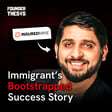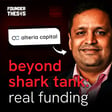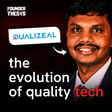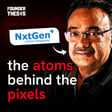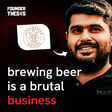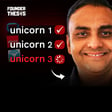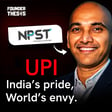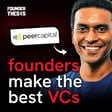Become a Creator today!Start creating today - Share your story with the world!
Start for free
00:00:00
00:00:01

Once tickled, twice ‘Oloid’ Part 1 | Mohit Garg @ Mindtickle & Oloid
From Pune to Unicorn status, Mindtickle's incredible journey is a must-listen. Mindtickle was founded in Pune in 2012 by a group of initially business-clueless engineers. Discover how they achieved product-market fit and successfully scaled to become a unicorn in the US enterprise SaaS market, recounted by Mohit.
For more such interesting founder journeys, subscribe to our newsletter founderthesis.com
Read more about Mindtickle:-
1. Mindtickle Enters Unicorn Club With SoftBank-Led $100 Mn Series E
2.SaaS Unicorn Mindtickle Acquires US-Based Enable Us To Empower Salespersons
Transcript
MindTickle's Journey to Becoming a Unicorn
00:00:00
Speaker
Hi, I'm Ohit Kirk. I am the founder and CEO of Oloid.
00:00:16
Speaker
There is a common investing thesis in the VC world called India for the world. It means investing in companies that are building in India for global markets, spending in rupees and earning in dollars. One of the pioneers of this thesis is a company called MindTickle. MindTickle was founded at Pune in 2009 by Bantiff engineers who were pretty clueless about business.
00:00:36
Speaker
But they kept at it and this is the story of how they found Market Fit, how they scaled to the US market and became a unicorn. In this two-part episode of the Found a Thesis podcast, your host Akshay Dutt speaks to Mohit Garg about his journey of founding MindTickle and scaling it up in the US as an enterprise SaaS business. You will also find part two of this conversation on the same feed which covers Mohit's journey of building his second startup, Olloid.
Mohit's Early Career and Education
00:01:09
Speaker
Well, I had multiple offers all in software. I took up a job in a company in Chennai called Future Software. I felt like...
00:01:21
Speaker
Systems programming is where I had a lot of interest. So building, not application software. And I ended up building software for routers and switches, networking and protocols. Tell me about that journey, you know, from first job to entrepreneurship when you started in Pine Pickles.
00:01:41
Speaker
In those days, you almost had to earn the right to start a business because there was no funding available. And then I also wanted to pursue master's. So even for that, I had to do some savings and find some way of funding my post-grad education. So as I was working at Future Software, I started preparing for my master's in electrical engineering at Stanford.
00:02:05
Speaker
At Stanford, I took courses in Dubai and one of the professors, Dr. Paul Raj, he was starting a startup. So he offered a couple of us in the department because he knew like we are just moved from India, we don't have a lot of resources. So I ended up doing my master's with Nolan.
00:02:29
Speaker
I ended up taking two and a half years to do my master's because I was working full-time. Then I got into the startup world. This is early 2000s and worked with that company. That company did amazingly well. They were building wireless technology called WiMax. The company got acquired by Intel and ended up working with Intel for a short while.
From Corporate Life to Entrepreneurship
00:02:51
Speaker
Then another company, L3 Communications, then acquired the assets of the company because of the dot-com bust.
00:02:57
Speaker
And I ended up working with a large company called electric communications. But that's when I realized working with a large company is not my thing. So within a few months, switched to another startup called Aruba Networks. And I had set a benchmark for me, which is, I'll go to US for five years, gain an experience and go back to India and start my business. That was my original plan. I came up on eight years. I said, what's pathogia? Now I should stick to my plan. Otherwise I'll be here forever.
00:03:23
Speaker
And that's when I had been hearing about ISB as an institute which was being built to global standards. And some of my friends who had an MBA, they advised me and they said, you'll spend a lot of money on US MBA. Because in my mind, again, I was still operating with some very high level assumptions that to be a business person, you need to have a business degree.
00:03:51
Speaker
And I said, I want to get an MBA. But given that I want to build a business in India, I felt ISB will be giving me the best of both worlds. And then in 2005, I moved back to India, basically said bye bye to the US. That was my plan to just be in India from that point onwards and went to pursue one year MBA program at ISB Hyderabad.
00:04:20
Speaker
So while at ISB, I was very clear that I am not going to go for the coveted jobs of consulting and investment banking. I did apply for an exchange program and ended up going to Kellogg School of Business as an exchange student from ISB just for the experience. And that's where at one of the socials, I met the consulting partners at a consulting firm called Diamond Consultants in Chicago.
00:04:46
Speaker
I was doing the exchange program at Kellogg at Chicago and this partner in the consulting firm.
00:04:52
Speaker
He brainwashed me in one hour. So he showed me on consulting in that one hour. And then he said, next week we have interviews at Kellogg. I'll recommend you. You put in your resume. So I did the same, got interviewed at Kellogg, got a consulting offer. So almost four years, more than four years of managing consulting at a consulting firm in Chicago.
00:05:17
Speaker
Yeah, I can see PwC also on LinkedIn. Yeah, so in 2010 PwC acquired Diamond Consultants. Diamond Consultants was a boutique consulting firm. I enjoyed it because it was just 500 or so consultants. We were doing very high quality work and as a small consulting firm, we were very focused on quality and not scale.
00:05:39
Speaker
And then once PwC acquired, obviously it was a massive cultural shift or the company was operating at massive scale. And I could see that the experience is not going to be the same, but at this point I felt I had checked all the boxes.
00:05:55
Speaker
for me to take the plunge having earned consulting salary for four months. It was pretty rewarding. I had a forced test to say, I can now be two years, three years without a salary and it's okay. I can survive handsomely while being an entrepreneur. And you were still on an H1B visa? Back then, if you had a master's and you applied for a green card, that was pretty quick.
00:06:19
Speaker
So the wait times were not that long. So before I went to ISB, I had already taken a green card in the US. And that was an option value to say, okay, you know, even if I have to come back, travel, everything will be easy. So at ISB, I made some of my lifelong friends, some very, very close friends.
Founding and Initial Focus of MindTickle
00:06:39
Speaker
One of those people is Krishna, Krishna Deepura, who was my co-founder at MindTicle.
00:06:45
Speaker
And at ISB itself, we had sort of made a pact that we will do a startup together. We had done a lot of business plans together. In fact, there are three, four of us who were branded as they want to fund companies, they have a plan. So we were part of that pact.
00:07:04
Speaker
And Krishna and I kept in touch. And we always used to talk about what's happening in his life and does he feel ready? So that was leading up to, okay, let's start figuring out the team, let's figure out which area, let's do some market research. So I actually did my return to India second time and packed my bags and moved to Pune.
00:07:30
Speaker
where Krishna was already there. Krishna had two other colleagues of his at the startup he was working with called Popmatic, Deepak and Nishant, who were also very good friends. So they also came along and all four of us, we co-founded together. So we all had done some experiments. For like kids, like what said went?
00:07:55
Speaker
The experiments we ran in 2010 were around using gamified learning for general knowledge, for learning about history. We ran a gamified contest around Indian history.
00:08:12
Speaker
We had a hypothesis that will build something about gamified learning. And we didn't know which segment, whether it's going to be kids, whether it's going to be corporate. So we did experiments in all those areas. At that point, we found with kids, there was so much academic focus. We didn't want to build any programs for like, you know, eighth grade mathematics and how to crack boards or how to crack the, that didn't excite us. We believed in holistic learning.
00:08:41
Speaker
And we did our own primary research and we felt like parents weren't willing to pay for holistic education and learning. They'll pay for cracking the exam.
00:08:52
Speaker
And that didn't excite us. So after doing some initial experiments around B2C learning, gamified learning, like we still have, you know, Facebook pages we had created, which have 40,000 followers even today, right? And we were getting like, you know, some of the gamified programs that we created, Facebook games that we created, like they used to get like,
00:09:15
Speaker
15,000 concurrent users. So we had a lot of engagement, but monetization wasn't clear to us.
Pivot to B2B Enterprise Software
00:09:22
Speaker
It seemed like building this concept for an enterprise B2B will have the grounding of a successful business, otherwise it'll end up being a hobby. So then that's the time when we actually built some form of a pitch deck
00:09:42
Speaker
When is this when you decided to pivot to B2B? Very early on, I would say in the first year itself, we were still not incorporated. We were still doing experiments. Who was coding? If you made a Facebook game and all that, there were four of you, so all of you knew how to code and all that.
00:10:05
Speaker
Deepak and Nishant are very, very versatile. From a technology standpoint, Nishant is a great designer. Deepak is multifaceted. He is everything from an architect to a programmer and now a very strong CTO. We also had a couple of early team members that we brought on board.
00:10:32
Speaker
very, very early career, very motivated. Those engineers have done amazingly well. So with about six of us, we rented a small little bungalow. And we used to hang out there and used to code and we used to do wire trimming of
00:10:52
Speaker
We started pitching this concept to HR departments in Bangalore. Initially, we pitched team engagement. We said we will do online team building using our games. We looked at the demographics because our games were
00:11:12
Speaker
seeing more and more of participation from early professionals. Right. So also factor of the network like Krishna had an amazing network and Microsoft and Pubmatic and the world was spreading around around these games and their Facebook games. So the sharing was happening in those Facebook groups, a lot of posts. And these were like essentially trivia games. Trivia games.
00:11:37
Speaker
mostly general knowledge trivia games. That's what we showed to this HR department. Check the audience, check the engagement, see how much passion people bring. We had discussion boards and people were doing discussions around trivia, even at 2am. We said, imagine we could do this for your employees for employee engagement.
00:11:57
Speaker
We got some early adopters who got excited and Moby was one of our very early adopter customers who said, okay, we'll give it a shot. Let's do a team engagement game. We did that for HPE, for Yahoo.
00:12:08
Speaker
And one thing was very clear that the user engagement was very hard. Consistently, whatever we were building, all users were asking for more. They're asking the HR department, is the next time we're going to have an activity like this? And that's in the name my integral also came about. This was December 2011 is when we incorporated the company. And by then, we had clarity that it's about gamified learning.
00:12:33
Speaker
By then, we were convinced it's going to be a B2B company. One of our classmates, Neeraj Arora, ended up being an initial angel investor. When we shared the idea with him, we got pretty excited. We brought in Amit Samani, who runs PrimeAngels now. He was the second angel investor. So,
00:12:55
Speaker
That's where the story started taking off very soon after Excel India gave us a seat check. They said, you know, we like the team. We know there is something there, what you guys are doing. Your user engagement is very high. We want to back you as an early team,
US Market Focus and Company Evolution
00:13:12
Speaker
go figure it out. We'll give you some funds to go figure it out.
00:13:16
Speaker
Oh, now we've got some investor money. So now we've got to get serious and deliver on some objectives. And I would say the resources available today are maybe 1000 times more than were available in 2011.
00:13:32
Speaker
So back then, we had limited access within India. Everything you're consuming was from US blogs and US founders. We started consuming those. And I think that's when we started understanding the one-on-ones of what a tech startup is. So it was a fast learning curve, starting to understand, okay, what we are doing, putting stuff on AWS is actually called a cloud-based SaaS service.
00:13:58
Speaker
So even like that thing, it wasn't like a household name. SAS, now everybody knows, right? Just putting some nomenclature around the category of business, what are we building, enterprise software, building something initially as an HR software, understanding what is the ecosystem, right? Also understanding
00:14:20
Speaker
how should we price it and charge it, right? Because initially we started looking at event-based pricing, okay, you know, in Mopi, do a team engagement event or a new hire event, online event, and you give us a per event. After we got funded, started to understand, you know, met with people like Shekhar Kirani, who had just, Freshworks was funded, I think within plus minus two months of my people getting funded with Accel India.
00:14:46
Speaker
So, Sheikhar started sharing all the insights about, okay, how are the Zoho people thinking about their business, right? Go meet with Girish, pick up his brains, and understand, because he's further along in the curve of understanding how this model is cracked. So, with the Accel Network, we started getting access to learning resources, meeting people who were much more educated and savvy, and also started figuring out geography,
00:15:16
Speaker
Now that whole romantic model of India is my market to now understand your enterprise software. There is very little success to be had as an India-only focused enterprise software or SaaS company.
00:15:29
Speaker
Pretty much all companies look at the U.S. as a market. So, started with that patriotic zealot building something for India to then understanding, okay, now the responsibility towards delivering value to investors, they can't do that until you crack the U.S. market. So then, once we had an initial product, initial product was a new hire onboarding product, so we actually productized it.
00:15:51
Speaker
What we were doing as team engagement, sort of one-time-and-done type of gamified learning, we started going into a recurring learning model as new hires come into the organization, how you're educating the new hires about their company, their product, their competition, everything they have to learn as a new hire to get an understanding of the company's must-know information.
00:16:18
Speaker
You would live in a gamified manner. So that had decent uptake. And this was like text plus quizzes, like some text information and then multiple choice questions and you select one and with some animations when you select the right answer, like what was it like?
00:16:36
Speaker
So we are done pretty much from day one, everything visual. To give you an example, one of the team engagement games that Mindticle was still doing until a couple of years back, maybe they're still doing today.
00:16:49
Speaker
was one of those classic games we invented called High Fly. So High Fly was a trivia game, very visual, where you keep on answering questions and your balloon rises and different teams, they have otter balloons, and they're competing, right? Whose balloon reaches the top, the fastest. So there was always a visual journey component to what we were building the games and gamified learning we were building, right? And then we had
00:17:15
Speaker
done a lot of thinking around different formats of games. It shouldn't be MCQ. MCQ was the most boring format. Let's find Hangman. Let's find fill in the blanks. We had created a lot of these. DNA was product thinking. DNA was build once and reuse.
00:17:33
Speaker
We had created frameworks about everything. Everything was a journey. When you had journey, you had a background. You could have the background of a mountain that you're ascending. You could have the background of a nice bicycle ride like Tour de France. We had created this product where you could create custom background with the company's logo.
00:17:57
Speaker
and upload an image, a JPEG, and it tailored the experience to that company's new hires. It didn't feel like it was a one-size-fits-all, right? It feels like that company's brand colors and everything. It was very easy to customize. It made it very customizable. And the questions were put in by the company itself, or was it done by you for them?
00:18:20
Speaker
Yeah. So we started creating frameworks and saying, typically onboarding has these five different things, but the company, it's history. So we would give them a template and ask them to fill a template. We had templatized the whole model. And then soon enough, we made itself service. Whereas you put in the questions, you put in the answers, you do the scoring, right? Everything became like a
00:18:42
Speaker
you know what we know today as a templatized sas software right with the admin portal and what were you charging companies like per person unbounded so every new higher batch you would make like a you know thousand dollars for every batch of you know whatever 50 people who are coming in
00:19:03
Speaker
And how did you start selling in the US? This you're talking of US pricing, right? So we did have breakthrough with US companies with offices in India. So everything from Yahoo to HP, multinationals. Multinational technology companies is where we had our initial traction. And then we went to the US counterparts and said, oh, your Bangalore office had a lot of success with this. So that's how we started penetrating US market.
00:19:32
Speaker
And as we were also getting more savvy about understanding how to build a meaningful business, we needed to be a line item in the budget. So we started quantifying, are we able to get onboarding done faster? Are employees becoming productive faster? Can we introduce product training? Can we introduce sales training? Can we introduce not just about my company's basics, done in four hours, to now meaningful modules, right?
00:19:58
Speaker
And we started to have business value discussions saying, okay, we'll price to value and talk to HR about business value and time to onboarding.
00:20:05
Speaker
But we realized HR was not the buyer who thought like that and bought like that, at least back in the day. Whereas the sales teams who were using our product, they were very excited to engage in discussion about saying, okay, my sales hire takes four months to be productive. If you can shave off a month from it, I can quantify that. I think that was a light bulb moment for us. The moment we felt like we could quantify
00:20:33
Speaker
the impact into dollars, now we can build a meaningful business. So we started moving more and more towards sales-oriented learning programs. Sales onboarding. We put a lot of energy into understanding the sales persona. What is the sales hire? What are the different programs that they learn, right? There is sales techniques that they have to learn. They have to learn about competition, pricing. So those modules, it started about company's history, vision,
00:21:02
Speaker
they started morphing into product differentiation, competition, pricing. So a lot of energy started going into pursuing that persona from a new hire perspective. And then we said, why only new hires? The product was not imparting knowledge as such, but it was doing like a fun ways of assessing knowledge. And that assessment in a way also reinforced the knowledge.
00:21:31
Speaker
Yeah, so we actually added modules for even delivering the content. So we started investing into abilities to create content directly, be able to import Google Slides or import PowerPoint, and then later on import videos, embed video links. So it started taking more and more the format of a full learning platform.
00:21:57
Speaker
it was gradually morphing towards becoming like an LMS, but a more gamified LMS than what would have been around those
Expansion of Gamified Learning Platform
00:22:06
Speaker
days. Yeah, I would say that we actually got the award for best gamified learning platform. They must have been 2013, right? So from a gamification standpoint, they were made of the curves. But then we also realized that
00:22:22
Speaker
LMS is not something we want to be. We want to be more than LMS, right? We want to be a platform which is driving value. So, that's why today it's called a sales readiness platform because learning is a small part of it, right? As we started understanding this persona, just knowing my company's product and being able to, you know, rattle off my company's features doesn't close a deal. So, what closes the deal? What makes us new higher success? So, what makes a salesperson achieve quota?
00:22:51
Speaker
We started to understand that there are many frameworks around this, the frameworks around how is this person able to communicate value. So we introduced the ability for new hires to record themselves like I'm speaking with you.
00:23:09
Speaker
start the recording on their laptop, record a video, and submit it. And the managers can review it and give them feedback, like we called admissions. So it went from trivia-based learning to sort of gamified e-learning to now learning which impacts outcomes, makes salespeople productive and effective sellers, right? Making the best videos. So if I was, let's say, a sales team of 70 people,
00:23:38
Speaker
There are three-star sellers. Their videos are available for me to play and learn from. So, peer-to-peer learning became a very important part of the platform. Then we did integration with platforms like Salesforce.com. Now, content could be tied to what type of deals am I selling? Am I selling in pharma? Am I selling in manufacturing?
00:24:00
Speaker
So then the videos and content related to Parma case studies will become available to me. So a little bit of content management features started coming into it. One question here, how did this content library get built? So this you're saying is like user generated content, like the learners would at the time of
00:24:19
Speaker
When a company signs up, then everyone goes through the module and they submit their videos. Those videos which people submit as part of the assessment, that gets added to the content bank. We realized that we can't rely on just company-provided content. We need to invest into user-generated content and crowdsourcing of content.
00:24:43
Speaker
So exactly to your point, I may be sales hire number 431.
00:24:50
Speaker
But there are 430 people who were hired before me. Of those 430 people, some of the videos must have been really good and spectacular. So it doesn't have to be people who joined with me in my batch, but historically best examples need to be highlighted. So there was a voting system, there was a grading system, there was a rating system. There was ability to boil up the best piece of content that drives success, which are good examples to learn from.
00:25:16
Speaker
So we invested in several principles. We had discussion boards where nois could ask questions and there could be meaningful discussion. So we started with this notion of, you know, we used to call it Sogamo, which is social gamified mobile. So we tried to coin a word Sogamo learning, right? So at this point, you know, we had cracked the code of learning. We knew that in online learning, we are the champs. What we are starting to realize is we are more than learning.
00:25:46
Speaker
How do those case study videos get in? Because you're collecting videos as part of onboarding journey for a new customer, right? Like when there would be some questions and as an answer to the question you record, like say communicating value, you give an example. But how does that, how do the case studies enter the system? So today, developing success stories or case studies
00:26:14
Speaker
is a very formal process in organizations. Because sales enablement, you can say is the company setting up their sales people for success is sales enablement. And how do you set your sales people with successes? The first thing is you have to deliver a compelling product and value proposition. You have to deliver a pricing model that is attractive and it's compelling.
00:26:39
Speaker
And you have to not deliver narratives with the sales people can use. So narrative is not just a pitch. It's not just about saying my product is better and so forth. It's about we have worked with customers like you, and they have been successful. So that's a case study. So today, there's a standard process in organizations where customer success teams, they are rewarded and compensated for making their customers referenceable.
00:27:05
Speaker
When you make a customer referenceable, they'll either do a G2 cloud review for you, or if they are even more intimate with you, they'll give you a video testimonial of some sort. And then you also have processes, best companies also have processes where as soon as a salesperson closes a deal, they will record a win story and say,
00:27:24
Speaker
I sold to the CIO. I had a three-month sales cycle. We had this type of evaluation. We were competing against this competitor. Because we had this ability to respond to this customer's business needs, have this feature, we won against this competitor. So all of these now starting packaged as codified learning, as videos.
00:27:44
Speaker
And now in our platform, we had the ability to import them and boil them up at the moment of need, right? So we also came up with a lot of interesting taglines saying, preparing self-trips for the moment of truth. Moment of truth is in front of a customer. So how do you prepare them? You prepare them in the right content, right learning, right narratives. It's called command of the message, command of the sale. There's a lot of frameworks around sales effectiveness. So one of those we incorporated into our platform. It became much, much more than our limits.
00:28:13
Speaker
This data was already labeled. You didn't have to work around labeling it in order to identify which video should be shown when that labels are important. That is where you build a valuable company, right? Because now you're taking all of this, you know, I'm summarizing in five minutes for you.
00:28:34
Speaker
But all of this institutional knowledge of what drives sales success, right? Our early customers were Nutanix, Cloud Data, AppDynamics. These companies had the best sales teams in the US SaaS ecosystem. So working with their sales enablement leaders, working with their sales training teams, working with their sales leaders and understanding what drives sales success got codified as templates in our platform.
00:28:59
Speaker
So now it's a new company who's earlier in their journey or doesn't have that high caliber sales people.
Sales Best Practices and Platform Growth
00:29:07
Speaker
They have implementation of best practices from best in the breed. So our customers actually helped us become smarter, right? We were not sales experts, right? But we had worked with high quality sales teams as customers and we were smart enough to absorb what they were telling us and make them features and a product, make them templates. So essentially you are
00:29:29
Speaker
making sales best practices available as a subscription to companies. Yes, we implemented all the best practices in a templatized manner for organizations to take advantage of. Give me some examples of what kind of features allowed companies who did not follow best practices to start following them. Give me examples of some product features which help salespeople to become more effective.
00:29:55
Speaker
Like one of course you've told me like the Salesforce integration that they're serving up content. What else? There's another I mentioned which is about being able to record yourself and get feedback. That is a very effective tool for a new salesperson, right? Because when you are joining a new company,
00:30:16
Speaker
having the right narrative about how to even do a basic description of what is the company about. Why is this differentiated? Why is it better versus competition for a certain set of customers? What are some examples of companies who are using the product successfully? Some of those basic narratives
00:30:37
Speaker
fine-tuning those narratives without putting them through a human process in a classroom, doing at their own pace. I think the next generation sellers really resonated with that because prior to that, the old generation sellers were sitting in a classroom and doing pitch practice. Being able to do it on my computer in my own time
00:30:58
Speaker
I think unlocked a lot of value. We used to call it missions, pitch practice. That was a very, very useful feature our customers took advantage of. Now, my integral has features where they're integration with Zoom and other recording software, where AI would analyze the meeting.
00:31:21
Speaker
And then you would get data. Okay. So, like, the live sales pitch is getting recorded and analyzed, right? So, conversationally, now you can do assessment of what percentage of the time did the customer speak, what percentage of time did the salesperson speak, right? How many times was a competitor mentioned, right?
00:31:46
Speaker
How long was the pricing discussion? The opportunities are endless. You can do emotion analysis. There are opportunities to also start providing prompted content based on the conversational AI. You are in a meeting and then AI can prompt you on content that would be useful or references to case studies or customers that would be useful. Okay, got it.
00:32:12
Speaker
So you were in Pune when you started, how did you land up in the US then? So after we realized that we have to succeed in US as a market, 2013, we already had customers in India, multinationals in India, which we have referrals to speak to the US counterparts. So I started making trips in US to meet with these companies and meet the US teams.
00:32:43
Speaker
So I did like two or three trips in that year, 2012, 2013 time frame. And then I think then I ended up doing seven months in the US because there was like so much of sales discovery that we had to do as we're moving specifically towards the sales enablement market.
00:33:05
Speaker
He realized there's a lot of customer discovery to be done. So I spent seven months, my family was at Kune and I had a child who was just born. So it was just not working out from a personal standpoint, being away with a very young child.
00:33:22
Speaker
So my first bond was seven months old when we decided to pack our bags and go to the US so the family could be united. It was very clear to me that one of the co-founders, whoever is driving the revenue side of the business,
00:33:38
Speaker
We'll have to be close to the customers, especially because it's a new category, new product, and new customer, and we don't have any proxy for that in India. If we build a product with Indian customers, this will not meet the needs of the core market. So, I move to the US.
00:33:55
Speaker
Yeah, India was still adopting CRM. It was at that stage where CRM was getting adopted. You needed customers who have already got CRM sorted and are looking at next level. Right, exactly. And you were essentially the face of the company for customers in terms of leading the sales and heading up US sales.
Mohit's Role in US Expansion
00:34:18
Speaker
I'm guessing the sales team would have been largely based in the US.
00:34:21
Speaker
Yeah, that's right. Yeah. So we had a US sales team, we had some marketing and SDR, BDR functions in India, but all sellers were in US. In fact, I was involved in every single deal as a founder seller in the first 50 customers. And then obviously started pulled back on founder selling and started to get more into
00:34:48
Speaker
you know, have sales leaders, a VP of sales, and then you have customer success or teams and leadership. So it started more and more of the traditional sales team structure. But all of that was built in the US in the Bay Area. And you were responsible for the fundraising also?
00:35:06
Speaker
Krishna was leading the charge on fundraising. I was in charge of revenue. So I had a revenue leadership role. I was tag teaming with Krishna. So we used to always pitch together, but I was focusing on revenue and Krishna was focusing on all the overall company building. Okay. Okay. Okay.
00:35:29
Speaker
Tell me the journey of pricing. You must have gone through a journey to discover what is the right pricing. You initially started with a couple of dollars per onboarding done, and then once you pivoted into the sales model, what was the pricing journey like?
00:35:46
Speaker
Yeah, it was very clear to us that we want to do a per-user SaaS subscription pricing. I think for our software, the end users were sales reps. And if you think about value-based pricing, a company with a larger sales team gets more value from identical than a smaller sales team.
00:36:07
Speaker
So all that made sense. The model never got pushed back from customers. What we did realize is this beautiful upsell model where you could start with a basic introductory startup back with a startup, and then you could upsell them on more sophisticated features like the video recordings and the AI. So we actually went from
00:36:31
Speaker
know, like $15 per user to 70 plus $75 per user per month for a full featured product, right? So we were at this time also able to triple our account size going from, you know,
00:36:47
Speaker
$11,000 average ACV to 40,000 plus ACV. So yeah, that was on account of adding more value to our products and customers appreciating how that impacted sales outcomes. And that's what I say, we had stayed in a HR centric software, we have not been able to cross this journey, which we've had, because we were tied to business outcomes and sales outcomes. Okay.
00:37:13
Speaker
So around 2018 is when you kind of moved out. At that stage, what kind of ARR was my integral and how much fundraise had it done? Like what was the state of the company at that stage? Yeah, company was at series C stage. And yeah, we had raised almost $55 million at that point. And yeah, the company
00:37:39
Speaker
This $55 million is a pretty big amount. This is on the back of that global opportunity, like investors would have been interested in buying TCL as a global SaaS business. Yeah, I would say between 2014 and 2018, we had established ourselves as a US-centric business. Like 95% of business was coming from US. Right, right, okay. So at this point, you know, we didn't have to justify that it's a global company. We were a US-first company. Right, right, right.
00:38:07
Speaker
And we were a US-first company with a very efficient cost model where we had a very strong team in India that could support everything from our customer success, engineering, product standpoint, support standpoint. And then we had a front-facing, highly effective sales team in the US. It's a marketing team in the US.
00:38:31
Speaker
So we were also capital efficient, not just growing fast, not just a leader in our space as a first mover. We were also very capital efficient. So we got a lot of acknowledgement for being a leader early mover and being capital efficient. Okay. And then what caused you to move out when you had built it up from scratch?
Transitioning from MindTickle
00:38:54
Speaker
So my role was that of a chief revenue officer at my table.
00:38:57
Speaker
like founder CRO is a very rare profile, I would say in the tech industry. Generally, CROs are career sales leaders who have started their journey in sales or customer success. They've either gone from a cold caller to account seller to enterprise sales rep. They spent 20 years and then they have lead teams, regional RVP, VP of sales, CRO. So for me,
00:39:27
Speaker
As a pure engineering pedigree, having learned sales and driving revenue, VP of sales reporting to me, that was a very fast learning curve. And I delivered that to the best of my abilities to a point where we were already talking about, okay, how many years to IPO, how many years to 100 million year, what does this look like? Because now you're getting some very high quality investors with massive rounds of funding coming to the company.
00:39:57
Speaker
And I think one question every founder should ask oneself is, am I the right person for the role that I'm playing in the company? And I honestly felt I had reached my level of incompetence when it comes to leading revenue as a CRO of the company. I had the opportunity to stay and be relevant as a chief strategy officer. That was the role that was being discussed. We had just recently hired a president who was taking over day-to-day CRO responsibilities for me.
00:40:27
Speaker
because the board and I, we felt like we need to take this company and lock its full potential. We need to get somebody seasoned, somebody seasoned who has seen scale, seen couple of hundred million of year. We were hiring
00:40:41
Speaker
career enterprise sales people, right? Some of the sales reps we hired, they themselves had single handedly carried tens of millions of dollars of quota. And you know, we're reporting into me where I didn't have revenue leadership experience. I felt like we needed somebody seasoned to come and take up this role. And
00:41:03
Speaker
I also felt the value I would add once, you know, we basically ended up with five BPs and one president taking over the responsibilities I was getting at one point, right? So we hired really well. I placed myself with very high quality talent.
00:41:20
Speaker
So I felt like it was time for me to also think about how unlock my own potential as a founder and go on the CEO route and see how I can not only impact revenue, but also impact product, impact fundraising, be at the helm of the company, overall company building and not just revenue, book a business building. So I felt like that was the right decision and the right time to execute the decision.
00:41:47
Speaker
And that brings us to the end of this conversation. I want to ask you for a favor now. Did you like listening to the show? I'd love to hear your feedback about it. Do you have your own startup ideas? I'd love to hear them. Do you have questions for any of the guests that you heard about in the show? I'd love to get your questions and pass them on to the guests. Write to me at adatthepodium.in. That's adatthepodium.in.
